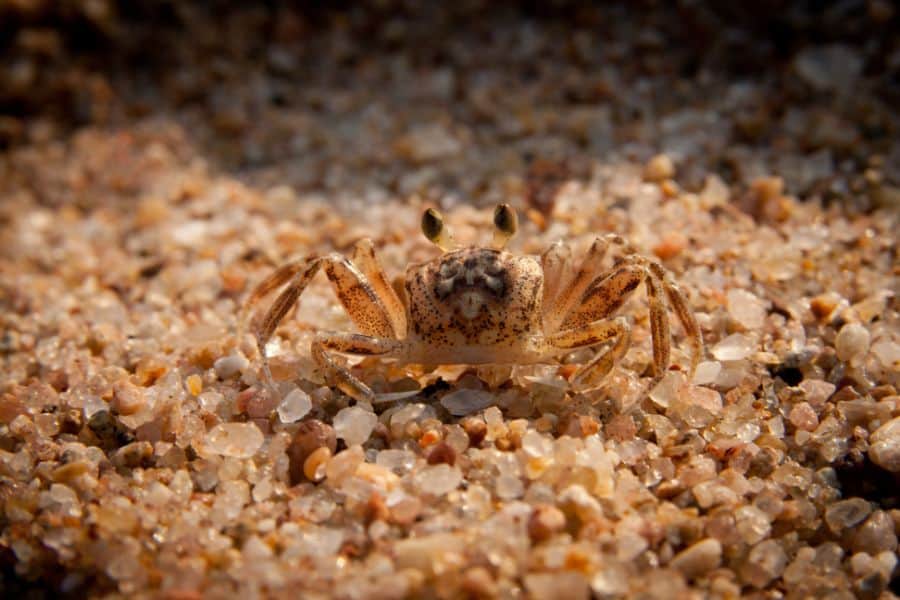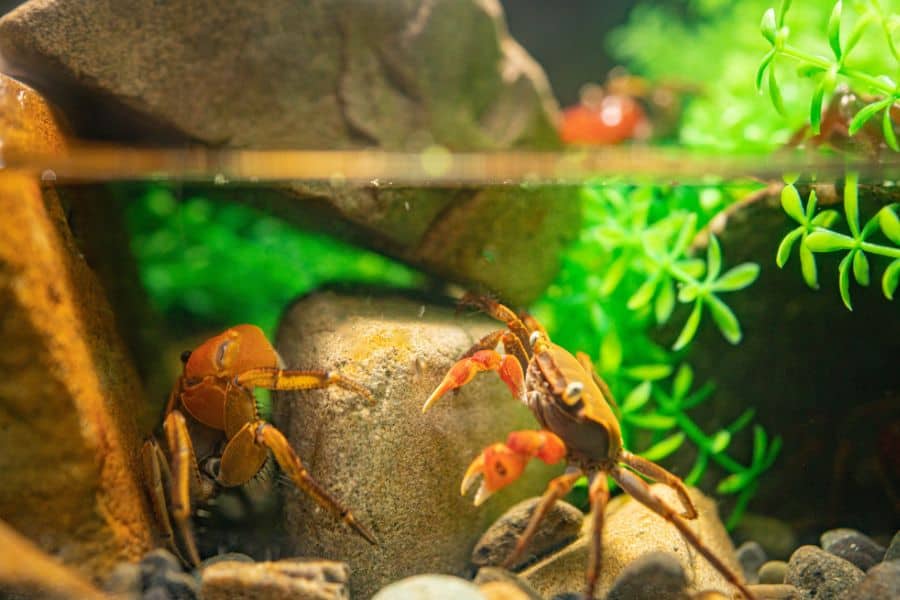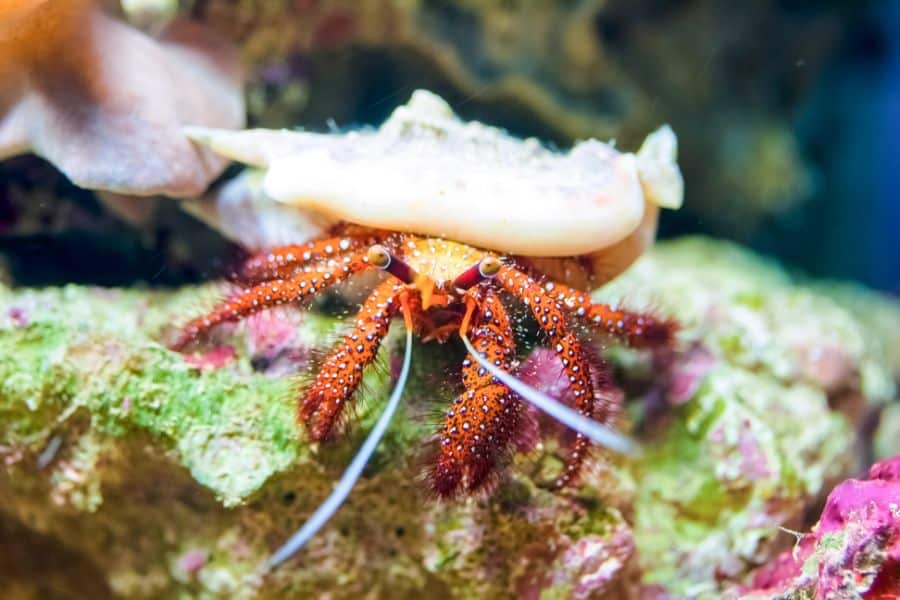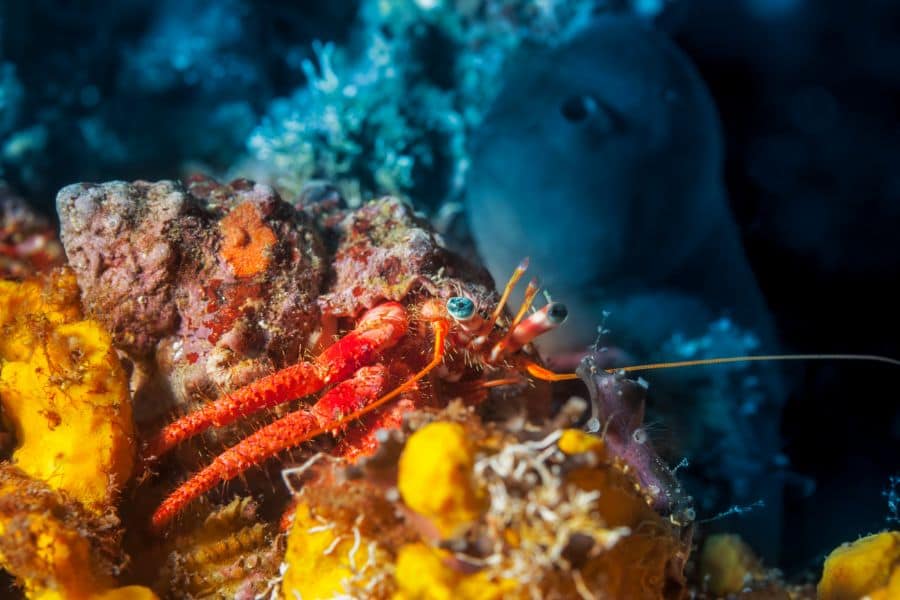So, you’ve recently found some small crabs that you thought would fit well in your aquarium, but you’re unsure what to feed them in order to keep them healthy.
In this article, we’ll be going over everything there is to know about a crab’s diet, including in nature and at home, and how it can differ depending on the crab.
Crabs are mainly hunters and scavengers that feed on a variety of animal (and some plant) based matter, such as fish, crustaceans, shrimp, algae, and seaweed. Many factors, such as location, size, and species, determine the diet of a crab, but many are not fans of spicy, acidic, or preservative-added foods.
Let’s first go over a little background on crabs so that you’d have a better idea of why they eat what they eat.
Some Background on Crabs
Crabs are, in short, any short-tailed member of the crustacean order Decapoda, which belongs to the class Malacostraca and include groups such as the brachyurans and anomurans. Crabs appear in saltwater, freshwater, and on land, of which roughly 10,000 species have so far been identified.
Unlike other decapods, such as shrimp and lobster, crabs have their tails curled underneath their thorax/midsection. The broad carapace (dorsal exoskeleton) and the modified first pair of legs (known as chelae or pincers) also distinguish crabs from other decapods.
Habitat of Crabs
With so many species of crabs around the world, it comes as no surprise that they’ve adapted to live in all types of habitats, both in and out of water. Overall, a crab’s habitat will depend on its species.
An example of a crab that’s mainly limited to marine environments is the hermit crab, which typically requires saltwater to mate and molt. Some can live in freshwater as well, but most are found in the ocean or on sandy beaches, where they can survive using moisture in the air.
On the other hand, you have something like the yellow land crab, which is a terrestrial crab that lives in the forests from Cuba to Barbados. They typically live in habitats far from the ocean, and can sometimes climb trees in search of food.
Finally, there’s the sally lightfoot crab, which lives along the rocky shores that line up the American coasts. Similar to the hermit crab, the sally lightfoot also prefers to live near the ocean, however they spend most of their time in the rocky crevices on the shores, where the sea spray of the waves help keep their gills moist.
As you can see, the habitats of crabs vary quite a bit (though they all provide crabs with enough moisture), and at the end of the day, it really depends on their species that decides where these crabs live.
Eating Habits/Methods

How Do Crabs Find Prey
Similar to other marine animals, crabs use their sense of smell to detect prey.
They’re able to do so by using chemoreceptors that are located on their antennae to detect chemicals released by their prey into the water. These chemoreceptors appear as long, segmented appendages that are near a crab’s eyes.
Besides the chemoreceptors, crabs also have antennules, which are shorter appendages that resemble antenna and allow crabs to sense their environment.
Finally, tiny hairs on their mouth, pincers, and feet provide crabs a large surface area upon which they use to detect changes in the environment.
Crabs Are Very Sensitive to Taste and Smell
Though they don’t have noses and don’t taste food like we do, crabs nonetheless are particularly sensitive to taste and smell.
It’s because of their strong senses that fishermen often use pots and cages filled with animal parts to attract crabs. Particularly pungent foods, such as chicken necks and pieces of fish (i.e. ells, squid, herring, and mackerel), often act as excellent bait for catching crabs.
Since their sense of smell and taste are so strong, crabs can sometimes have their senses affected by bait, hence impeding their ability to detect prey.
How Do Crabs Eat
Crabs use their claws to break up food and place them into their mouths similar to the way we use utensils to help us eat. They take advantage of their claws to break through the hard shells of other animals while their many appendages allow them to quickly catch up to prey.
Crabs Dietary Details
Crabs eat a variety of animal and plant matter, but determining specific diets is ultimately up to a variety of factors, such as location, size, and the crab species.
What Do Crabs Generally Eat?
Here is a list of what crabs are generally known to consume:
- Algae
- Seaweed
- Worms
- Small clams
- Shrimp
- Squid
- Snails
- Mussels
- Other crabs
- Small fish
- Phytoplankton and Zooplankton
- Plant matter
Keep in mind that this list is by no means exhaustive, and provides only the most common types of foods that the majority of crabs eat.
What Can’t Crabs Eat?
Even though crabs are known for their dietary versatility, depending on the species, there are some foods that should not be fed to them lest you risk harming their health. Some common examples are as follows:
- Foods that contain chemicals such as pesticides and herbicides are harmful to crabs. Consider providing them fresh produce at all times
- Hermit crabs in particular are especially vulnerable to moldy or rotten foods. Feeding them these can cause them to become ill and eventually die
- Hermit crabs are also vulnerable to high amounts of iodine, meaning large amounts of table salt should not be fed to them
- Citrus fruits (i.e. oranges and lemons) are typically disliked by hermit crabs
- Skin and leaves of avocados are harmful to most animals, including crabs
- The leaves and stems of carnation flowers are poisonous
- Prune species of trees (i.e. bitter almonds, apricots, peaches) can be harmful if ingested. Only the fruits are edible
- Chocolate and cocoa, which both include a large amount of processed sugars and chemicals can be toxic to crabs and should be avoided
- Onions
- Garlic
- Catnip
- Cinnamon
- Lavender
- Peppermint
- Rosemary
In the case of hermit crabs, you should only use either purchased spring water or distilled tap water. Unpurified tap water contains chemicals and metals, which can damage the gills, eventually leading to the suffocation and death of the crabs.
Location Based Diets
Sometimes, crabs can have different diets based on where they live. Here are some of the common habitats where crabs can be found, and the diets typically associated with them:
What Do Crabs Eat in the Ocean?
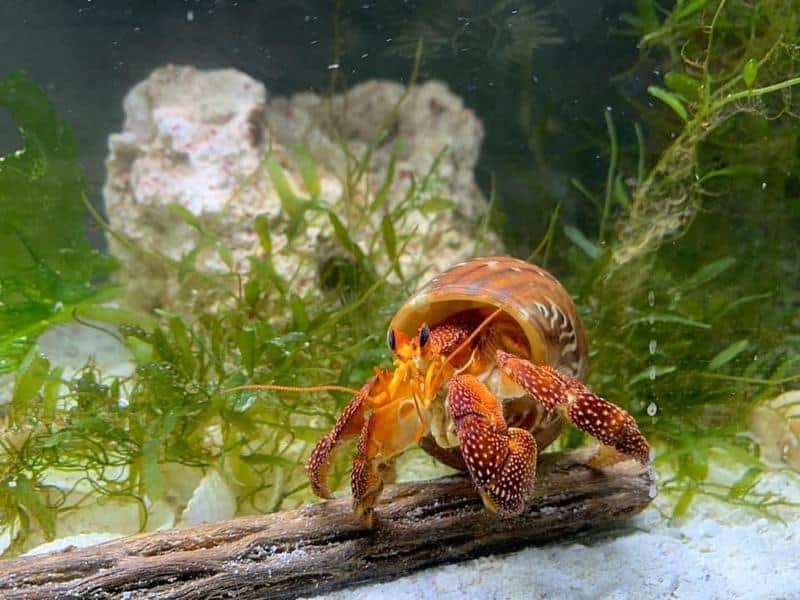
As scavengers, crabs eat just about anything they can find in the natural environment, with common foods including green and red algae, decaying animal and plant matter, and carrion (i.e. dead shrimp and fish). Other types of food may consist of seaweed, worms, live shrimp, and others.
Larger crab species typically feed on similarly larger prey, such as other crabs, mussels, small fish, and squid.
Occasionally, you’ll find crabs that are skilled inn consuming hard foods, such as barnacles, sand dollars, and starfish.
What Do Crabs Eat on The Beach?
Various crabs may spend some or most of their lives on the beach, however if you’re looking specifically at those that are known to live in the sand, you may look at the relatively good representative sand crab.
Sand crabs, unlike many other crab species that use their claws to grab and feed themselves food, use antennae to collect passing food particles in the water. As a result, they feed mainly on the very small or microscopic food particles in the water, such as plankton, detritus, and small shrimp.
More details on the sand crab can be found here.
What Do You Feed Pet Crabs?
Although crabs are not picky eaters, they shouldn’t be fed with just about anything. Keep in mind as well that terrestrial, semi-terrestrial, and aquatic crabs should be fed based on their species, as not all food fit for one group are appropriate for another (i.e. fruits may work for terrestrial/semi-terrestrial crabs, but not for aquatic ones).
With that said, here are some of the common items that crabs eat at home categorized into vegetables/fruits, protein, calcium, and commercial available foods (these commercial foods should be the staple of any crab diet as they provide the majority of the protein, vitamins, and nutrients needed to support a strong immune system and overall health):
Common Vegetables:
- Asparagus
- Basil
- Broccoli
- Beets
- Carrots
- Corn
- Cucumber
- Cauliflower
- Green beans
- Green peas
- Moss
- Pumpkin
- Peas
- Sprouts
- Zucchini
Common Fruits:
- Apples
- Avocado
- Bananas
- Blueberries
- Cherries
- Coconut
- Mango
- Melons
- Nectarines
- Olives
- Papaya
- Pears
- Plums
- Raspberries
- Watermelon
Keep in mind that fruits will need to be peeled and potentially sliced so that the crabs can have an easier time consuming them.
Common Sources of Protein:
- Beef
- Chicken
- Pork
- Fish
- Shrimp
- Brine shrimp
- Bloodworms
- Cockroaches
- Crickets
- Krill
- Snails
- Mosquito larvae
- Eggs (with shells)
Beef, chicken, pork, fish, and shrimp should all be served either raw or boiled.
Common Sources of Calcium:
- Kale
- Broccoli
- Spinach
- Seaweed
- Figs
- Nuts
- Cuttlebones
- Shells (from eggs, wonder, oysters, mollusks, etc.)
- Seeds
- Insect carapace
Common Commercially Available Foods:
- API Fish Food flakes
- Tetra Shrimp Wafers
- Frozen blood worms
- Shrimp pellets
- Shrimp granules
- Hikari Shrimp Cuisine
- Hikari Tropical Crab Cuisine
What Do Crabs Eat at Coral Reefs?
Crabs that live in coral reefs typically feed on things such as algae, plankton, small fish, invertebrates, and any other living organisms that call the reefs home.
Some crabs are known to have a symbiotic relationship with certain types of algae, in which they consume the algae before excreting it back into the water, hence providing the algae with nutrients to further their growth.
The coral crab in particular plays a crucial role in the maintaining of the coral ecosystem by developing a symbiotic relationship with the reefs. In this relationship, the crabs use their feeding appendages on their legs to stimulate the host colonies to produce lipid-rich mucus, which the crabs eat.
The coral in turn protects the crabs from predators while the crabs can also clean the colonies of debris and sediments (further details can be found here).
Size Based Diets
As mentioned earlier, one important factor that impacts a crab’s diet is its size, with larger crabs being able to handle similarly larger prey with potentially harder shells that smaller crabs would be unable to break open.
This, combined with the fact that larger crabs will also require more calcium, protein, and other nutrients to maintain their size compared to smaller crabs, means that their diets can differ significantly.
Thus, its more common to see larger crabs eating on things such as snails, other crabs, sea stars, sea worms, and small fish.
Smaller crabs, on the other hand, will usually feed on smaller prey such as microalgae, plankton, brittle stars, shrimp, and might also have a generally more plant-based diet.
Also Read:
Conclusion
Crabs overall have some of the most diverse diets in the world, though specific crabs typically have their own similarly specific diets.
As long as you know what crab species you have, you should have no trouble finding a large array of food choices available to keep your pet live a healthy life at home.
